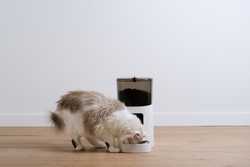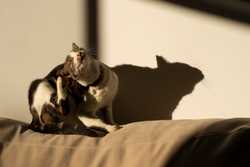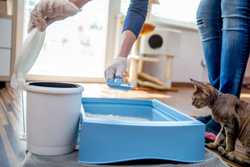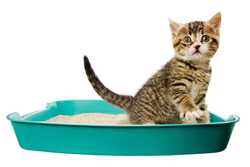- Type: Electronic
- Weight: 11.36 ounces
- Material: ABS plastic, rubber
- Lifestage: Kitten, Adult, Active seniors
- Price on publish: $26.00
Best Interactive Cat Toys: 8 Ways to Engage Your Feline’s Body and Mind
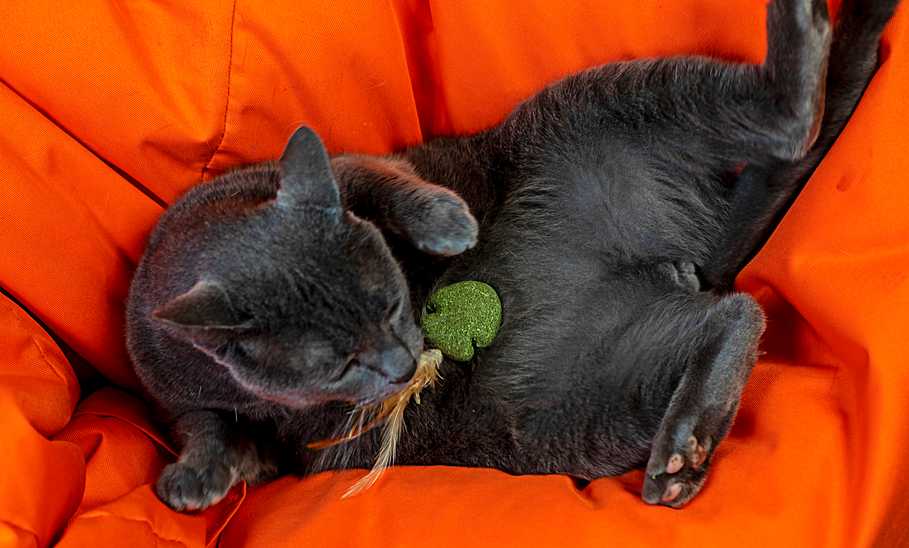
Our evaluations and opinions are not influenced by our advertising relationships, but we may earn a commission from our partners’ links. This content is created by TIME Stamped, under TIME’s direction and produced in accordance with TIME’s editorial guidelines and overseen by TIME’s editorial staff. Learn more about it.
As a cat owner, you’ve seen your pet’s pupils fly from small to all-systems-go in an instant. Admittedly, some of those times weren’t fun because they’re filed under vet visits or pet carrier fiascos. But during playtime, seeing your cat’s attention fully piqued is the best because you know your pet is mentally on board and ready to physically engage.
Maybe you haven’t seen this behavior in a while, and you’re wondering if your cat is bored. Cats are hunters and interactive toys can make their domesticated life more interesting. If your cat is indoors only and in need of more exercise, interactive toys can help with that as well. Some toys require you to play with your cat, which can strengthen the bond between the two of you. To help you explore what’s available, I’ve rounded up some of the best interactive cat toys to engage your feline friend’s body and mind.
![[object Object] [object Object]](https://i5.walmartimages.com/asr/297e56bb-7b3b-4843-9992-8e57114b0ff2.14ac820ff6e5f4788eea2b645f5a37b7.jpeg?odnHeight=450&odnWidth=450&odnBg=ffffff)
With its swiveling and turning movements, this electronic toy will stimulate your cat’s instinct to hunt. The toy will run for 10 minutes before automatically turning off to preserve battery life. After 90 minutes, it will turn on again, which adds to the unpredictability factor that cats tend to enjoy with prey. And this toy’s large wheels means it can run on a variety of floor types, including carpet.
This motorized toy can keep your indoor cat moving and entertained, even while you’re away.
![[object Object] [object Object]](https://i.etsystatic.com/14508457/r/il/381319/2954832686/il_794xN.2954832686_2ci0.jpg)
Despite the appeal of motorized kicker toys, I chose a traditional kicker. A lot of cat toys are imported and made with plastic, but this one is handmade by an Etsy Star Seller in Oregon, with over 2,800 sales. A Star Seller is known for things like outstanding customer service, five-star reviews, and shipping orders on time.
This particular item is also an Etsy Pick, which means this shop sells quality products that are reliable. This teal jumbo fish also doubles as a catnip toy. Some items in Luxe Meow’s shop are kept in stock in small quantities (but frequently restocked, so not to worry) while other items are made to order to ensure catnip freshness. Comes in teal, orange, marine blue, gray and green tea color, plus a smaller size version for $21.95.
This handmade, jumbo fish-shaped kicker is made with safe, quality components and will appeal to wool- and catnip-loving kitties.
![[object Object] [object Object]](https://i.etsystatic.com/10569539/r/il/91ea5b/5377356020/il_794xN.5377356020_b0gp.jpg)
This hand-sewn blanket is made by an Etsy Star Seller in Pennsylvania. I love that this is a catnip mat, which can encourage senior cats to stretch and move in ways that are comfortable for them. The crinkle sound adds to its stimulating quality, as does the olfactory stimulus of the catnip inside the blanket. It comes in an 11 x 17 inch size and a 17 x 17 inch size. Non-crinkle mats are also available.
This catnip blanket can encourage your senior cat to stretch and play, while the crinkle sounds can be mentally stimulating.
![[object Object] [object Object]](https://i.etsystatic.com/21725221/r/il/9401d9/2153716605/il_794xN.2153716605_2y0v.jpg)
This wood feeder puzzle comes in two sizes (medium and large), and is handmade by a five-star Etsy shop based in Delaware. If you feel this particular feeder would be too easy for your cat, you can tape over a couple of the sides as one person noted in their review of the product. If you want a more elaborate wood feeder, they are available and shipped from Etsy sellers in countries like Germany and Romania.
This handmade wood feeder is a great way to mentally engage food motivated cats and slow down fast eaters.
![[object Object] [object Object]](https://i.etsystatic.com/46795813/r/il/8b70a4/5577675204/il_794xN.5577675204_t22w.jpg)
This patent pending wand toy is made in New York by a five-star Etsy seller with over 350 sales. In addition to the three, 30” long yarn strands, the rattle ball and length of the wand are wrapped in cotton rope. This makes the Wiggle Wand™ enjoyable for cats to scratch and chew.
This sound-making wand will encourage you and your cat to play together.
![[object Object] [object Object]](https://i5.walmartimages.com/asr/250f17d8-c3e0-42a9-9655-1fd9863f1142.da56187c213633a5cd50d343ba38284a.jpeg?odnHeight=450&odnWidth=450&odnBg=ffffff)
This automated toy engages your cat’s instinct to chase. The interchangeable feather, ball, wand, and butterfly attachments provide different visual and tactile stimuli as well. After turning on the toy, it works for five minutes before going into standby mode. When reactivated by touch, it will work again for five minutes. This automated cat toy has a rotation feature with a slow and fast mode, plus it comes with a USB rechargeable battery.
This multisensory, interactive cat toy is great for an indoor cat needing something to chase, bat, and chew.
![[object Object] [object Object]](https://i.etsystatic.com/17945810/r/il/b305e2/2863289429/il_794xN.2863289429_a4mt.jpg)
This is a great handmade find from an Etsy Star Seller in Maryland. With a length of 30.75”, this extra large mat allows your cat to get a good stretch while scratching. It can be used flat or angled, with one end propped up on the legs that are included. There’s also a shorter version (SCRATCH THIS® Junior 2 in 1) that is available in a separate listing.
Whether your cat loves to sharpen their claws horizontally or at an upright angle, this made-to-last handmade product might put an end to the endless search for a bigger and better scratcher.
![[object Object] [object Object]](https://i.etsystatic.com/23062394/r/il/3c6779/4679604438/il_794xN.4679604438_o82h.jpg)
Made of wood, this cat tunnel is designed to last. With a carpeted surface, this aesthetically pleasing product also doubles as a scratcher. It comes in two different lengths and four height/width options. Shoppers can contact the McMinnville, Oregon artisan through Etsy to inquire about carpet color options.
This aesthetically pleasing, sturdy tunnel offers a place for your cats (and small dogs) to play, hide and scratch.
I tried to pick toys that were engaging in more than one way, especially for cats who potentially might be playing on their own for much of the day. For example, the kicker toy contains catnip, which lots of cats love because it stimulates their sense of smell, but it also contains wool, which some cats enjoy the texture and scent of as well. The shape of a kicker also tends to encourage cats to kick as if they’re eviscerating prey, which provides some exercise.
Some of the toys I picked also do more than one thing, such as move and have blinking lights. This is mentally stimulating, especially when it’s unpredictable, like a prey animal might behave. Multiple engaging features also encourage physical movement by sparking a cat’s instinct to hunt.
Though not all of the toys have replaceable or interchangeable parts, I made a point to include some that did. Though the cat kicker toy is not refillable, I did include another catnip product that can be refilled. For battery-operated toys, I selected ones that were rechargeable.
Most of my picks are handmade by Etsy sellers in the United States. Several of these shops are Etsy Star Sellers, which means that Etsy has recognized them as shops that provide a great, overall customer experience. This includes responsive messaging, five-star reviews and shipping orders on time.
My goal for picking handmade items was to give cat owners the option to buy products that are high quality and made of safer materials than plastic. Some of the products I picked are crafted with wood, while others are made with fabric or wool.
Signs of boredom in cats include overgrooming, inactivity, not playing with their toys, overeating, and destructive behaviors, like clawing your couch despite having appropriate places to scratch. If you have multiple cats, they might pick a fight out of boredom as well.
However, it’s good to keep in mind that all of these behaviors can also be signs of other issues. For example, maybe you’ve provided an appropriate object to scratch, but your cat prefers a different material, e.g. instead of carpet, they prefer cardboard because it shreds more readily. They may also prefer a vertical scratcher over a horizontal one because of the full-body stretch they can get. (Verticality and shredability are why cats tend to love couches!)
Besides boredom, overgrooming can also be a sign of various different skin conditions. And an increased appetite can indicate a medical issue such as hyperthyroidism.
Cats are great at disassembling things. So as a veterinarian, the first thing that catches my eye about pet toys are parts that might turn into a foreign body. Is a button eye or a plastic beak going to end up down the hatch and get trapped? (A foreign body is an unnatural object that’s lodged inside your pet’s body, such as in the stomach or intestines).
If you can examine a toy in person to see how sturdy it is, that’s ideal. If you’re shopping online, helpful information can sometimes be found in product reviews. And if a toy is battery powered, a zipper closure for the compartment housing the battery pack is preferable over velcro. Ultimately, if you buy a toy that you’re not sure will stay intact for long, only allow your cat to play with it while supervised.
A less commonly discussed factor for pet toys is plastic. As someone who is trying to reduce my own exposure to toxic chemicals like BPA, it’s something that I prefer pets avoid too. Just like when buying a litter box for cats, the world of pet toys is filled with plastic. If you’re inclined, consider BPA-free toys or non-plastic toys made of materials like fabric, wood, or wool.
Some plastic products, like the Trixie 5-in-1 Activity Center food puzzle toy (which I didn’t pick), are a great concept for engaging play and predatory behavior with food. This puzzle feeder is also BPA-free, but it has the Proposition 65 safety warning that it may expose you (and therefore your cat) to formaldehyde.
Safety standards tend to be higher for cat toys made in the United States, so when possible, take the country of origin listing into consideration.
Some toys are inexpensively made and you tend to know that when purchasing them. But if you’re spending more money on a product, replaceable parts are nice. For example, many cat toys have feathers, but these tend to break with play. If you know your cat is feisty with feathers, look for toys that can be replaced or swapped out for another type of attachment, like with some wand toys. And for battery-operated toys, to avoid disappointment within a matter of days to weeks, look for toys that are rechargeable.
The degree of interaction required for a toy to be fully usable varies. Some will require you to turn them on to make them move, while others require the toy to be on and then touched before any motion is activated. Some toys, like wands, will require you to play with your cat. Providing your pet with a variety of toys is nice to reduce boredom, and so they can play when you’re not home. Also consider your cat’s personality—a cat who gets skittish around noises, like from an automatic litter box or even a squeaker, would likely not play with a loud toy.
Since indoor cats tend to be more sedentary, are limited in the area they can explore, and are limited with the objects they have for play, it’s important to provide environmental enrichment for their physical and emotional well being. To help keep your cat active and entertained, provide them with a variety of toys that stimulate them through sight, sound, texture, movement and/or smell.
If your cat gets bored easily, rotate toys in and out every day to every few days or as needed. At any given time, make sure that the toys that are out offer a variety of ways for your cat to be engaged mentally and physically. It’s also helpful to offer food puzzle toys because cats are designed to pursue their food.
If possible, play with your cat for at least five minutes twice a day. This can be done with activities such as using a wand or ribbon toy or tossing wool mice. A fun way to change up playtime is to dim the lights or turn some lights off. If your cat is amenable to a leash, you can also take them out on walks. Spending time with your pet helps strengthen the human-animal bond, helps your cat get some exercise, and it’s good for the emotional well being of both person and pet.
Yes, cats do get bored of the same toy. Cats need to be provided with a variety of toys that engage their different senses, such as toys that move (especially toys that move unpredictably like their prey might), toys that make sounds, and toys that smell good, like catnip.
It’s also a good idea to rotate toys, putting some away for a while and bringing others out. How long “a while” is varies by cat. Some cats may be intrigued with a toy for a few minutes, a few days, a few weeks, or longer. Try changing your cat’s toys out daily or every few days and based on how they respond, adjust or maintain the rotation schedule from there.
Kelly St. Denis, MSc, DVM, DABVP (Feline), a board-certified feline medicine specialist who is a consultant for veterinarians on the Veterinary Information Network, recommends that pet owners play with their cats for at least five minutes twice a day.
Consistent interaction not only reduces a cat’s stress but it facilitates the bond between pet and owner. Though we often joke about how easy cats have it, a variety of things contribute to feline stress. One of these is not having enough of an outlet for their natural predatory behavior, both during playtime and feeding time. (Especially if you use an automatic cat feeder.) Cats are designed to catch their food, so a bowl is downright boring for a predator.
They also are stimulated by things that move, so immobile toys can become boring for some. Using a wand toy or otherwise engaging with your cat can help with boredom and stress. Feline stress can contribute to behavioral issues like destructive scratching and physical issues like obesity. Whether it’s with food-based toys or other objects, interacting with your cat is essential.
Another multifaceted area of stress can come from other cats in the household. Since not all cats get along well, having to share resources like bowls, toys, litter boxes, scratching surfaces, and areas to rest can all contribute to stress. As with people, stress can affect a cat’s physical and emotional well being, so it’s important to make time for play.
The information presented here is created by TIME Stamped and overseen by TIME editorial staff. To learn more, see our About Us page.
